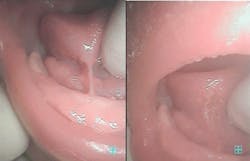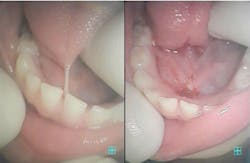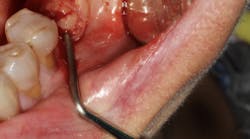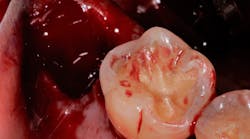Ankyloglossia (tongue tie) release using dental lasers
The condition known as ankyloglossia, or tongue tie, is surprisingly common in the general population (approximately three to four per 1,000 births) and can frequently be responsible for significant impact on healthy function in neonatals as well as infants and toddlers, even with long-term impact affecting adults for the whole of their lives.
The most common and earliest finding in relation to this condition is impaired or totally failed breast-feeding. This is due to the inability of some tongue-tied babies to attach successfully to their mother’s nipple to adequately suck the milk being presented to them. Despite this finding, many mothers of tongue-tied babies report successful feeding even with the reduced mobility of their infant's tongue. My repeated observations in relation to this suggest that when there is good milk flow, the baby is often able to feed well enough to thrive by simply “drinking” the milk that flows freely into their mouth when sucking is not able to be performed.
Releasing the restricted tongue as early as possible will commonly result in a huge improvement in the baby’s ability to breast-feed, eliminating maternal pain as well as enabling the baby to suck well.
Using the erbium dental laser to release the frenulum under the tongue is a highly successful and relatively straightforward procedure for infants. Following placement of topical anesthetic, the frenulum is exposed and the tongue is elevated, stretching the frenulum as much as possible to facilitate access. Care must be taken to avoid invasion of the salivary gland and its ducts under the tongue while releasing the frenulum. The laser reduces bleeding significantly and almost never necessitates placement of sutures. It also ablates soft tissue extremely rapidly, allowing the clinician to “get in and out” in a very short time frame without compromising safety or accuracy.
The second group of people commonly needing tongue-tie release are toddlers who demonstrate some form of impediment to the development of a full range of phonetic sounds while learning to speak. Release of the restriction results in rapid improvements that usually enable pronunciation problems to resolve quickly with appropriate help. Many of these children are reported to have failed to breast-feed, and the source of both of these issues has finally come to light, prompting corrective attention.
It is often necessary to administer a small dose of local anesthetic directly under the tongue into the frenulum to successfully treat this age group. Fortunately, this is a relatively pain-free site to inject into with careful management, and these patients usually do well despite an inherent lack of cooperation to treatment.
As mentioned, even adults can have persistent problems arising from untreated tongue-tie. There are two main areas that may improve for adults who undergo treatment. The first is improved ability to debride the teeth with the tongue following eating, which can reduce the well-understood etiologies associated with poor oral hygiene. The second consequence of reduced tongue mobility is the inability to use the tongue fully during adult intimate behaviors. Both of these issues can still be improved even later in life if adults wish to increase tongue mobility by having this treatment.
Case 1: Newborn, 7 days old, before and after.
Case 2: 8 years old, before and after.
Author bio
Dr. Laurie Kobler is a Sydney-based dentist who graduated from The University of Sydney in 1982. He runs a busy, suburban, general dental practice using a variety of the latest dental technologies. He has a keen interest in laser use in dentistry developed over approximately 10 years, and is a well-recognized leader in the field of tongue-tie treatment in Australia. He can be reached at www.tonguetie.com.au.




